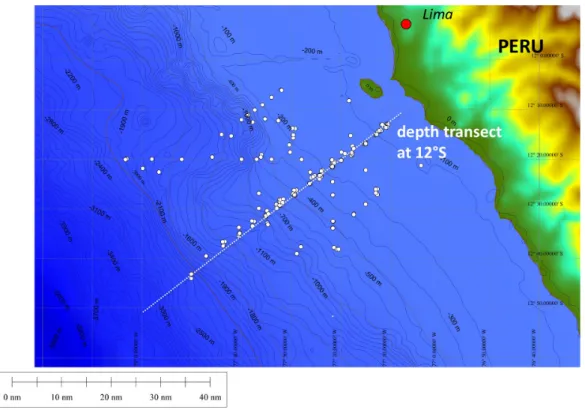Meteor cruise M137, Callao – Callao, 06. – 29. Mai, 4th
Weekly Report, 28. May 2017 Stefan Sommer and the M137 Team
During the last week of our expedition we successfully concluded our station programme and achieved more than 270 station also including 92 casts of the CTD water sampling rosette and 59 Microstructure stations, Fig. 1. The investigation of the water column further comprised deployments of the Trace metal CTD, 13 deployments of the in-situ pump, the Rapid Cast system and the Fish. The seafloor along the 12°S transect was extensively
sampled and we conducted 12 deployments of the BIGO Lander and 45 casts of the Multiple corer to obtain surface sediments. Major focus of the Lander work was on experiments conducted directly on the seafloor.
Fig. 1: Preliminary station map of METEOR cruise M137
These experiments were conducted at the shelf and the upper slope of the continental margin in water depths of 74, 129, 200, and 300 m. In contrast to the natural flux
measurements, during these experiments the effect of nitrate (NO3-) availability on nutrient fluxes across the sediment water interface was investigated. The availability of NO3- and to a lesser extend NO2- is important for the overall benthic turnover, specifically its processing into dinitrogen (N2) and ammonium (NH4+) by foraminifera and sulphur bacteria. During the process releasing the almost inert N2 reactive nitrogen is removed from the ecosystem, whereas during the latter pathway conducted by sulphur bacteria the reactive nitrogen is initially retained in the ecosystem.
Additionally, another experiment was carried out in 74 m water depth where in addition to NO3- oxygen was supplied to the benthic flux chamber. This site at the upper boundary of the oxygen minimum zone experiences fluctuating ventilation events, which were also recorded during this cruise, Fig. 2. Preliminary results of the experiments show that the sediments quickly respond to the addition of NO3- and thereby affect the seabed release of NH4+ and phosphate (PO43-).
Fig. 2: Oxygen variability in 74 m water depth. The measurements were continuously
recorded from a Mini Lander (SLM), which was moored at the seafloor for the duration of the Meteor cruises M136 and M137.
The finding that unicellular foraminifera are capable to store species specifically PO43- of up to 2 nmol per individual represents another highlight of this cruise and was not reported so far. Furthermore, it has been shown that with increasing water depth towards the lower boundary of the oxygen minimum zone at around 500 m the foraminiferal NO3- consumption increased. This hints to a shift of a sulphur bacteria dominated N-turnover at the shelf towards a N-turnover dominated by foraminifera at the upper slope strongly affecting the overall release of nutrients along this depth gradient.
During our research cruise we achieved a large and exciting data set. We expect that after the analysis and synthesis of the different results, which range from biological rate
measurements, in situ flux determinations, in- and ex-situ experiments, microbiological studies, genetics, to the physics and biogeochemistry of the water column and sediments we are able to contribute to better resolve and predict processes involved in the present
expansion of the oxygen minimum zone.
After final station work with glider and water column investigations, gears were prepared for their shipping back to Kiel and the laboratories we cleaned for follwing SFB754 cruise M138.
At Monday we will be back in Callao and look forward for a smooth container handling.
The scientific programme went very well. We very much would like to thank captain Rainer Hammacher and the entire Meteor crew for their excellent support and the always friendly atmosphere on board, which strongly contributed to this successful cruise.
With best regards,
Stefan Sommer and the entire M137-Team

